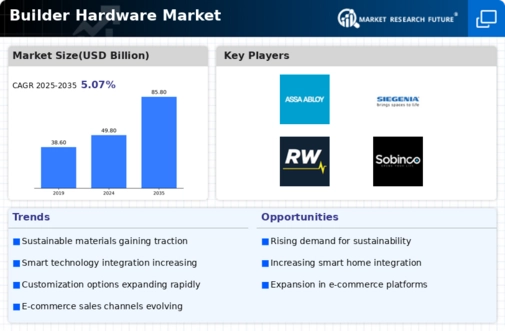Market Share
Builder Hardware Market Share Analysis
In the Builder Hardware Market, companies employ diverse strategies to position themselves effectively and secure a competitive advantage in terms of market share. Differentiation stands out as a prominent approach, with companies emphasizing unique features and qualities in their hardware products to set them apart from competitors. This could include innovative designs, superior materials, or specific functionalities, enabling companies to target distinct market segments. By offering products that stand out in the market, businesses aim to attract customers who value those particular attributes, helping them gain a significant share in specialized niches.
There exist several opportunities in the global builder hardware industry. One of the main opportunities arises due to the surge in the number of construction activities. It creates opportunities for business players to introduce new, improved and sustainable builder hardware solutions. There is also an opportunity to integrate innovation and advanced technology into the development of builder hardware solutions to offer more efficient and automated builder hardware equipment in the global market.
Cost leadership is another widely adopted strategy in the Builder Hardware Market, where companies focus on optimizing production processes and minimizing costs to offer their products at competitive prices. Efficiency improvements, economies of scale, and streamlined operations contribute to the ability to provide affordable yet reliable builder hardware. By adopting a cost leadership strategy, companies aim to appeal to price-sensitive customers, capturing a broad market share by offering cost-effective solutions without compromising on quality.
Market segmentation plays a crucial role in positioning strategies within the Builder Hardware Market. Companies divide the market into distinct segments based on factors such as geography, building types, or specific applications. Understanding the unique needs and preferences of each segment allows businesses to tailor their products and marketing efforts accordingly. This targeted approach enables companies to secure a larger market share within each segment, as customers perceive their builder hardware as more suitable for their specific requirements.
Strategic partnerships and collaborations are also instrumental in market share positioning. Builder hardware manufacturers often form alliances with distributors, retailers, or construction companies to enhance their market presence. These collaborations can lead to expanded distribution channels, increased brand visibility, and shared resources, all contributing to a broader market share. By partnering with complementary businesses, companies can tap into new markets and benefit from each other's strengths, creating mutually advantageous opportunities for growth.
Customer-centric strategies are paramount in the Builder Hardware Market, where understanding and addressing customer needs play a pivotal role. Investments in customer service, obtaining feedback, and continuous improvement based on customer preferences help build strong relationships. By prioritizing customer satisfaction, companies can enhance customer loyalty, leading to repeat business and positive word-of-mouth, ultimately contributing to an increased market share.
Innovation is a driving force in market share positioning within the Builder Hardware Market. Companies that invest in research and development to create innovative and technologically advanced hardware solutions gain a competitive edge. Innovative products that offer enhanced performance, durability, or energy efficiency are attractive to customers seeking cutting-edge solutions. Staying ahead of industry trends through innovation allows companies to capture a larger market share by meeting the evolving demands of customers and maintaining a reputation for forward-thinking solutions.








Leave a Comment